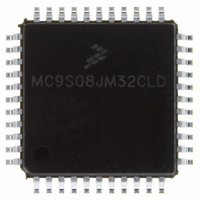MC9S08JM32CLD Freescale Semiconductor, MC9S08JM32CLD Datasheet - Page 259

MC9S08JM32CLD
Manufacturer Part Number
MC9S08JM32CLD
Description
IC MCU 8BIT 32K FLASH 44-LQFP
Manufacturer
Freescale Semiconductor
Series
HCS08r
Datasheet
1.MC9S08JM32CLD.pdf
(388 pages)
Specifications of MC9S08JM32CLD
Core Processor
HCS08
Core Size
8-Bit
Speed
48MHz
Connectivity
I²C, LIN, SCI, SPI, USB
Peripherals
LVD, POR, PWM, WDT
Number Of I /o
33
Program Memory Size
32KB (32K x 8)
Program Memory Type
FLASH
Ram Size
2K x 8
Voltage - Supply (vcc/vdd)
2.7 V ~ 5.5 V
Data Converters
A/D 8x12b
Oscillator Type
External
Operating Temperature
-40°C ~ 85°C
Package / Case
44-LQFP
Processor Series
S08JM
Core
HCS08
Data Bus Width
8 bit
Data Ram Size
2 KB
Interface Type
SCI/SPI
Maximum Clock Frequency
24 MHz
Number Of Programmable I/os
33
Number Of Timers
8
Maximum Operating Temperature
+ 85 C
Mounting Style
SMD/SMT
3rd Party Development Tools
EWS08
Development Tools By Supplier
DEMOJM, DEMOJMSKT, DEMOFLEXISJMSD, DEMO9S08JM16
Minimum Operating Temperature
- 40 C
On-chip Adc
8-ch x 12-bit
Lead Free Status / RoHS Status
Lead free / RoHS Compliant
Eeprom Size
-
Lead Free Status / Rohs Status
Lead free / RoHS Compliant
Available stocks
Company
Part Number
Manufacturer
Quantity
Price
Company:
Part Number:
MC9S08JM32CLD
Manufacturer:
Freescale Semiconductor
Quantity:
1 948
Company:
Part Number:
MC9S08JM32CLD
Manufacturer:
Freescale Semiconductor
Quantity:
10 000
- Current page: 259 of 388
- Download datasheet (5Mb)
Any switching between 8- and 16-bit data transmission length (controlled by SPIMODE bit) in master
mode will abort a transmission in progress, force the SPI system into idle state, and reset all status bits in
the SPIxS register. To initiate a transfer after writing to SPIMODE, the SPIxS register must be read with
SPTEF = 1, and data must be written to SPIxDH:SPIxDL in 16-bit mode (SPIMODE = 1) or SPIxDL in
8-bit mode (SPIMODE = 0).
In slave mode, user software should write to SPIMODE only once to prevent corrupting a transmission in
progress.
15.4.5
To accommodate a wide variety of synchronous serial peripherals from different manufacturers, the SPI
system has a clock polarity (CPOL) bit and a clock phase (CPHA) control bit to select one of four clock
formats for data transfers. CPOL selectively inserts an inverter in series with the clock. CPHA chooses
between two different clock phase relationships between the clock and data.
Figure 15-13
figure, the eight bit times are shown for reference with bit 1 starting at the first SPSCK edge and bit 8
ending one-half SPSCK cycle after the sixteenth SPSCK edge. The MSB first and LSB first lines show the
order of SPI data bits depending on the setting in LSBFE. Both variations of SPSCK polarity are shown,
but only one of these waveforms applies for a specific transfer, depending on the value in CPOL. The
SAMPLE IN waveform applies to the MOSI input of a slave or the MISO input of a master. The MOSI
waveform applies to the MOSI output pin from a master and the MISO waveform applies to the MISO
output from a slave. The SS OUT waveform applies to the slave select output from a master (provided
MODFEN and SSOE = 1). The master SS output goes to active low one-half SPSCK cycle before the start
of the transfer and goes back high at the end of the eighth bit time of the transfer. The SS IN waveform
applies to the slave select input of a slave.
Freescale Semiconductor
SPI Clock Formats
shows the clock formats when SPIMODE = 0 (8-bit mode) and CPHA = 1. At the top of the
Data can be lost if the data length is not the same for both master and slave
devices.
MC9S08JM60 Series Data Sheet, Rev. 3
NOTE
Serial Peripheral Interface (S08SPI16V1)
259
Related parts for MC9S08JM32CLD
Image
Part Number
Description
Manufacturer
Datasheet
Request
R
Part Number:
Description:
Manufacturer:
Freescale Semiconductor, Inc
Datasheet:
Part Number:
Description:
Manufacturer:
Freescale Semiconductor, Inc
Datasheet:
Part Number:
Description:
Manufacturer:
Freescale Semiconductor, Inc
Datasheet:
Part Number:
Description:
Manufacturer:
Freescale Semiconductor, Inc
Datasheet:
Part Number:
Description:
Manufacturer:
Freescale Semiconductor, Inc
Datasheet:
Part Number:
Description:
Manufacturer:
Freescale Semiconductor, Inc
Datasheet:
Part Number:
Description:
Manufacturer:
Freescale Semiconductor, Inc
Datasheet:
Part Number:
Description:
Manufacturer:
Freescale Semiconductor, Inc
Datasheet:
Part Number:
Description:
Manufacturer:
Freescale Semiconductor, Inc
Datasheet:
Part Number:
Description:
Manufacturer:
Freescale Semiconductor, Inc
Datasheet:
Part Number:
Description:
Manufacturer:
Freescale Semiconductor, Inc
Datasheet:
Part Number:
Description:
Manufacturer:
Freescale Semiconductor, Inc
Datasheet:
Part Number:
Description:
Manufacturer:
Freescale Semiconductor, Inc
Datasheet:
Part Number:
Description:
Manufacturer:
Freescale Semiconductor, Inc
Datasheet:
Part Number:
Description:
Manufacturer:
Freescale Semiconductor, Inc
Datasheet:











